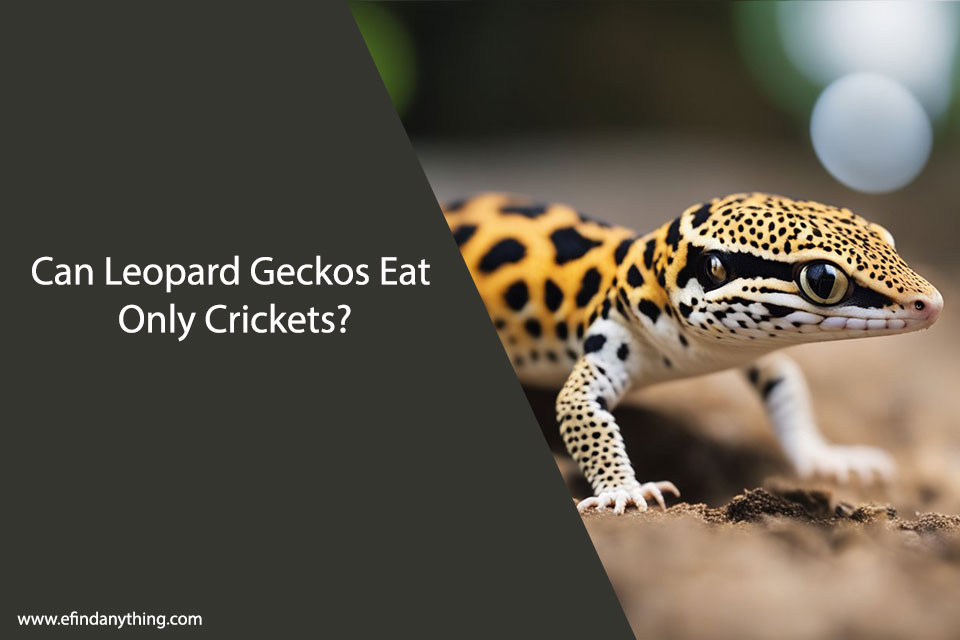Leopard geckos are one of the most popular reptiles kept as pets. They are easy to care for, have a docile temperament, and come in a variety of colors and patterns. As with any pet, it is important to provide them with a balanced diet that meets their nutritional needs. One of the most common questions that leopard gecko owners ask is whether their pets can eat only crickets.

Crickets are a staple food for leopard geckos and are readily available at pet stores. They are a good source of protein, which is essential for the growth and maintenance of muscle tissue. However, a diet consisting solely of crickets may not provide all the nutrients that leopard geckos need to thrive. In the wild, leopard geckos eat a variety of insects, including mealworms, waxworms, and superworms, as well as small rodents and other prey.
Table of Contents
Can Leopard Geckos Eat Only Crickets
Leopard geckos are known to be insectivores, which means they primarily feed on insects. The most commonly fed insect to leopard geckos is crickets. However, can leopard geckos eat only crickets?
The answer is no. While crickets are a staple in a leopard gecko’s diet, they need a variety of insects to meet their nutritional requirements. Feeding only crickets can result in nutritional deficiencies, which can lead to health problems.
Leopard geckos require a diet that is high in protein and calcium. Crickets are a good source of protein but are low in calcium. Therefore, it is essential to provide a variety of insects to ensure that leopard geckos receive a balanced diet.
Some other insects that can be included in a leopard gecko’s diet are mealworms, waxworms, super worms, and dubia roaches. Each insect has a different nutritional value, and offering a variety of insects will help ensure that leopard geckos receive all the necessary nutrients.
In conclusion, while crickets are an essential part of a leopard gecko’s diet, they cannot eat only crickets. A variety of insects must be offered to ensure that leopard geckos receive a balanced diet that meets their nutritional requirements.
Nutritional Needs of Leopard Geckos

Leopard geckos are insectivorous reptiles and require a diet that is high in protein and low in fat. In the wild, they feed on a variety of insects, including crickets, mealworms, and waxworms. However, in captivity, many owners tend to feed their leopard geckos only crickets, which may not provide all the essential nutrients required for their health.
Leopard geckos require a balanced diet that includes a variety of insects to meet their nutritional needs. In addition to protein, they require vitamins, minerals, and other essential nutrients such as calcium, phosphorus, and vitamin D3. Calcium is particularly important for the development of strong bones and egg-laying females.
Feeding only crickets to leopard geckos may lead to nutritional deficiencies, especially if the crickets are not gut-loaded or dusted with supplements. Gut-loading involves feeding the crickets with nutrient-rich foods, such as fruits and vegetables, before feeding them to the leopard gecko. Dusting involves coating the insects with calcium and vitamin D3 supplements before feeding them to the leopard gecko.
It is recommended to vary the diet of leopard geckos by including other insects such as mealworms, waxworms, and superworms. However, it is important to note that waxworms and superworms should only be fed as occasional treats due to their high-fat content.
In conclusion, while crickets are a staple food for leopard geckos, they should not be the only source of food. A varied diet that includes a variety of insects and is supplemented with calcium and other essential nutrients is crucial for the health and well-being of leopard geckos.
The Role of Crickets in a Leopard Gecko’s Diet

Leopard geckos are insectivores, and crickets are one of the most common staple foods in their diet. In this section, we will discuss the role of crickets in a leopard gecko’s diet, including their protein content, vitamins and minerals, and feeding frequency and quantity.
Protein Content
Crickets are an excellent source of protein for leopard geckos. They contain approximately 20% protein, which is essential for growth and development. Protein is also necessary for repairing tissues, maintaining healthy skin, and producing enzymes and hormones.
Vitamins and Minerals
Crickets are not only rich in protein but also contain essential vitamins and minerals. They are a good source of calcium, which is necessary for strong bones and teeth. Crickets also contain phosphorus, which works with calcium to maintain healthy bones. Additionally, crickets are a good source of vitamins A and D, which are essential for maintaining healthy eyesight and skin.
Feeding Frequency and Quantity
Leopard geckos should be fed crickets regularly, but the frequency and quantity of feeding depend on the age and size of the gecko. Hatchlings should be fed every day, while adult geckos can be fed every other day. The number of crickets to feed depends on the size of the gecko, but a good rule of thumb is to feed as many crickets as the gecko can eat in 15-20 minutes.
In conclusion, crickets play a vital role in a leopard gecko’s diet. They are an excellent source of protein, vitamins, and minerals and should be fed regularly to maintain a healthy and balanced diet.
Risks of a Cricket-Only Diet
Nutritional Deficiencies
Leopard geckos require a balanced and varied diet to maintain optimal health. A diet consisting solely of crickets may lead to nutritional deficiencies, particularly in calcium and vitamin D3. Calcium is essential for proper bone growth and muscle function, while vitamin D3 aids in the absorption of calcium. Without adequate levels of these nutrients, leopard geckos may develop metabolic bone disease, which can cause deformities, fractures, and even death.
Lack of Variety
Feeding leopard geckos only crickets can also result in a lack of dietary variety. In the wild, leopard geckos consume a variety of insects, including mealworms, waxworms, and roaches. Each insect provides different nutrients, and a varied diet ensures that all nutritional needs are met. A cricket-only diet can also lead to boredom and stress, which can negatively impact a leopard gecko’s overall health.
To ensure optimal health, leopard geckos should be fed a varied diet of appropriately sized insects, including crickets, mealworms, waxworms, and roaches. It is also important to dust the insects with a calcium and vitamin D3 supplement to prevent nutritional deficiencies. By providing a balanced and varied diet, leopard gecko owners can help their pets live long, healthy lives.
Supplementing a Cricket-Based Diet
Leopard geckos are known to be primarily insectivores, with crickets being a staple in their diet. While a cricket-based diet can provide the necessary nutrients for a healthy gecko, it is important to supplement their diet to ensure they are receiving all the essential vitamins and minerals they need.
Calcium and Vitamin D3
Calcium and vitamin D3 are crucial for the growth and maintenance of a leopard gecko’s bones. Without enough calcium, geckos can develop metabolic bone disease, which can lead to deformities and even death. Vitamin D3 is necessary for the absorption of calcium, so it is important to make sure geckos are receiving both nutrients.
One way to supplement a cricket-based diet with calcium and vitamin D3 is through the use of calcium powder. Calcium powder can be dusted onto the crickets before feeding, ensuring that the gecko is receiving the necessary nutrients. It is important to use a calcium powder that also contains vitamin D3, as calcium cannot be absorbed without it.
Other Insect Options
While crickets are a great source of protein for leopard geckos, it is important to offer a variety of insects to ensure they are receiving a balanced diet. Mealworms, waxworms, and superworms are all good options for geckos, but should not be the sole source of their diet.
It is important to note that some insects, such as fireflies and lightning bugs, are toxic to leopard geckos and should never be fed to them. Additionally, wild-caught insects may contain pesticides or other harmful substances, so it is best to stick with insects purchased from a reputable source.
Gut Loading and Dusting Techniques
In addition to offering a variety of insects, it is important to properly gut load and dust them before feeding them to geckos. Gut loading involves feeding the insects a nutritious diet before feeding them to the gecko, ensuring that the gecko is receiving all the necessary nutrients.
Dusting involves coating the insects with a vitamin and mineral supplement before feeding them to the gecko. This ensures that the gecko is receiving all the necessary nutrients, even if their diet is primarily crickets.
In conclusion, while a cricket-based diet can provide the necessary nutrients for a healthy leopard gecko, it is important to supplement their diet with calcium and vitamin D3, offer a variety of insects, and properly gut load and dust their food. By following these guidelines, gecko owners can ensure their pets are receiving a balanced and nutritious diet.
Feeding Techniques and Best Practices
Live Prey vs. Frozen
Leopard geckos are known for their love of crickets, but they can also eat other live prey such as mealworms, waxworms, and superworms. Some gecko owners prefer to feed their pets frozen prey, as it can be more convenient and can reduce the risk of parasites and disease. However, it is important to note that some geckos may not accept frozen prey or may prefer the movement and stimulation of live prey.
Safe Handling of Crickets
When feeding crickets to leopard geckos, it is important to ensure that the crickets are healthy and free from parasites. It is also important to avoid overfeeding, as this can lead to obesity and other health problems. To prevent escape, crickets should be placed in a shallow dish or container with smooth sides. Geckos should be monitored during feeding to ensure that they are not accidentally ingesting substrate or other foreign objects.
Monitoring Gecko Health and Diet
In addition to providing a varied diet of live prey, it is important to monitor the health and diet of leopard geckos. Signs of illness or malnutrition can include weight loss, lethargy, lack of appetite, and abnormal behavior. To ensure optimal health, geckos should be provided with a balanced diet, appropriate lighting and temperature, and access to clean water. Regular veterinary check-ups can also help to identify and treat any health problems before they become serious.
Alternatives to Crickets
Leopard geckos are known to be picky eaters, and while crickets are their primary food source, it’s important to provide them with a varied diet. Here are some alternatives to crickets that can be included in their diet:
Mealworms
Mealworms are a popular choice for leopard geckos and are readily available at most pet stores. They are high in protein and fat, making them a great supplement to a gecko’s diet. However, it’s important to note that mealworms have a hard exoskeleton, which can be difficult for geckos to digest. It’s recommended to only feed them in moderation and to avoid feeding them exclusively.
Waxworms
Waxworms are another option for leopard geckos, but they should only be fed as an occasional treat due to their high-fat content. They are soft-bodied and easy to digest, making them a great option for geckos that struggle with harder insects. However, they should not be fed as a staple food source due to their lack of nutritional value.
Dubia Roaches
Dubia roaches are becoming a popular alternative to crickets due to their high nutritional value and ease of digestion. They are high in protein and low in fat, making them a great staple food source for leopard geckos. They also have a soft exoskeleton, making them easy to digest. However, they can be more difficult to find and may be more expensive than other options.
In conclusion, while crickets are a great source of nutrition for leopard geckos, it’s important to provide them with a varied diet. Mealworms, waxworms, and dubia roaches are all great alternatives that can be included in their diet to ensure they are getting all the necessary nutrients.
Frequently Asked Questions
What variety of insects can be included in a leopard gecko’s diet?
Leopard geckos are insectivores, and in the wild, they consume various insects such as crickets, mealworms, waxworms, and roaches. Therefore, a leopard gecko’s diet should include a variety of insects to ensure they receive a balanced diet and all the necessary nutrients.
Are mealworms a suitable sole food source for leopard geckos?
Mealworms are not a suitable sole food source for leopard geckos as they have a high-fat content and low calcium to phosphorus ratio, which can lead to nutritional deficiencies. Therefore, it is recommended to include other insects in their diet to ensure a balanced nutritional intake.
Is it harmful to feed leopard geckos dried insects?
Dried insects can be fed to leopard geckos, but they do not provide the same nutritional value as live insects. Live insects are more nutritious and provide essential moisture, which is crucial for a leopard gecko’s health.
How should mealworms be presented to leopard geckos as food?
Mealworms should be presented in a dish or bowl that is shallow enough for the leopard gecko to reach and eat from easily. It is also recommended to dust the mealworms with calcium and vitamin D3 powder before feeding to ensure the leopard gecko receives the necessary nutrients.
What are the risks of leaving crickets in a leopard gecko tank overnight?
Leaving crickets in a leopard gecko tank overnight can be harmful as they can bite and harm the leopard gecko. Additionally, crickets can also hide and breed in the tank, leading to an infestation.
Do leopard geckos require a diverse diet, or can they thrive on a single insect type?
Leopard geckos require a diverse diet to ensure they receive a balanced nutritional intake. While they can survive on a single insect type, it is not recommended as it can lead to nutritional deficiencies and health problems. Therefore, it is essential to include a variety of insects in their diet.





